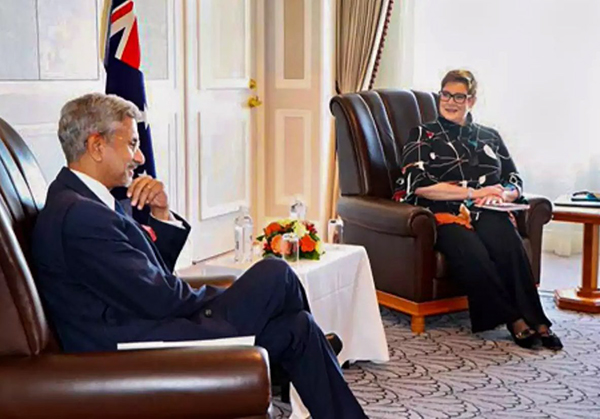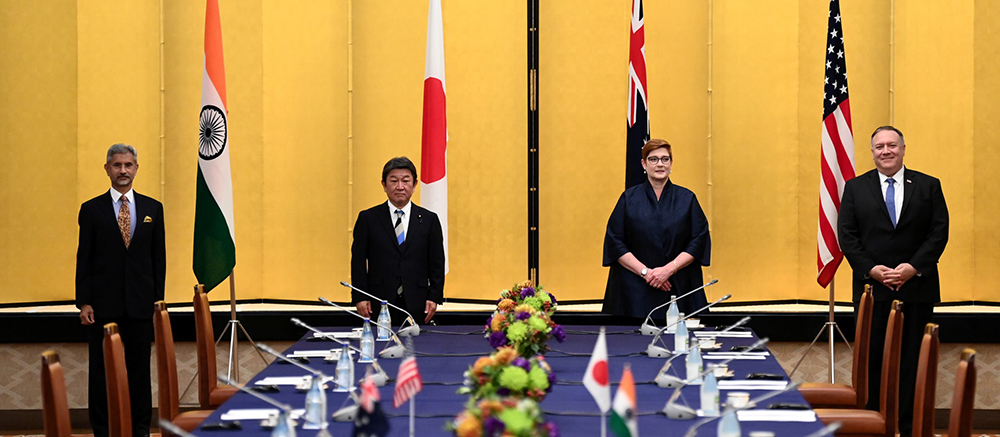
With Australia having joined the Indian, American and Japanese navies in the November 2020 Malabar exercises, co-operation among the Quad countries looks more concrete. It was the first time that all the Quad countries participated. The four nations had been engaging diplomatically so far under the Quad rubric.
So far, one or the other of the Quad countries has been reluctant to ruffle Beijing’s feathers at different times. After participating in joint exercises with India in 2007, Australia pulled away, wary of evoking Chinese displeasure. India, too, had been reticent about participating in a grouping directed against China. China’s belligerence in recent months has forced the Quad countries to shed such inhibitions.
The coronavirus, concerns over Chinese government actions in Hong Kong, the treatment of Uyghurs in Xinjiang, military incursions into the South China Sea and political interference have all given an impetus to strengthen the Quad.
The Quad
In response to China’s aggressive policies, the Quad – a strategic coalition of the Indo-Pacific region’s leading democracies (US, India, Japan and Australia) – is solidifying its alliance. Following a meeting of the foreign ministers of the four countries in Tokyo, on 6 October, the four countries are now actively working toward establishing a new multilateral security structure for the region.

There are efforts to develop a close security partnership founded on shared values and interests, including the rule of law, freedom of navigation, respect for territorial integrity and sovereignty, peaceful dispute resolution, free markets, and free trade.
China represents a growing challenge to all these principles.
European Support
The Quad’s focus also extends to ensuring a stable balance of power within a “free and open Indo-Pacific.” While all of the Quad partners agree in this principle, Chinese expansionism that has accelerated their recent actions. Even United Kingdom, France and Germany view it (rules-based Indo-Pacific) as essential for international peace and security.
France has appointed an ambassador for the Indo-Pacific, after unveiling a new strategy affirming the region’s importance in any stable, law-based, multipolar global order.
In September 2020, Germany, Europe’s largest economy, which has long enjoyed close ties with Beijing, released its first Indo-Pacific strategy focused on increasing diplomatic pressure on China.
Germany has sought to develop an Indo-Pacific strategy for the European Union. It has released policy guidelines, which call for measures to ensure that rules prevail over a “might-makes-right” approach in the Indo-Pacific. Germany currently holds the European Council presidency.
France
Apart from the Quad, which also includes Australia and Japan in addition to the US, India has been exercising regularly with France. The last one was conducted at French Reunion Island in the expanded Indian Ocean waters. India has discussed conducting similar exercises with the UK and Russia.
Giving up its reluctance to offend China which whom it has business interests, French president Emmanuel Macron has appointed Christophe Penot, his ambassador to Australia, to the new post of ambassador for the Indo-Pacific, realising the danger of Chinese hegemony.
During Macron’s visit to India in March 2018, addressing a French gathering in New Delhi, he reminded his countrymen: “France is a power of the Indian and Pacific Oceans; we are present at Reunion, we are also there in French Polynesia and New Caledonia. And we are a maritime power, it is often forgotten but France is the second maritime power in the world. We have a strong navy, we have nuclear submarines equipped like few other powers in the world; a maritime surveillance capability through our own satellites and technologies; it is obvious we are a military and intelligence power ranking us among the first nations in the world.”
C. Raja Mohan and Darshana Baruah wrote for Carnagie India, in 20028,on Deepening the India-France Maritime Partnership, thus: “As maritime security acquires greater salience in India’s foreign policy, New Delhi is increasingly looking to leverage its strategic partnerships, particularly with Paris. Although India and France have joined forces on a number of issues since 1998, regional cooperation in the Indo-Pacific has never risen to the top of the agenda. However, this may be about to change.”
New Multilateral Security Arrangement
The Quad was resurrected in late 2017, but in late-2019, it gained momentum, when its consultations were elevated to the foreign-minister level. It had been lying dormant for nine years.
Since the US, Japan and Australia are already tied by bilateral and trilateral security alliances among themselves, the future of the Quad hinges on India. India is also directly facing Chinese territorial aggression besides having a large border with it. This aggression has changed the strategic equation. With India having taken a confrontational position, the Quad is now more likely to shift from consultation and coordination to a strategic alliance for a new multilateral security arrangement for the region.
ALSO READ: JOINT EXERCISES – Quad Navies Hold 24th Malabar Exercise
The US has been working on getting India into a “soft alliance” devoid of any treaty obligations. On October 26-27, Pompeo and US Secretary of Defense Mark Esper visited New Delhi for the 2+2 Dialogue with their Indian counterparts. The meeting concluded with India signing the last of the four foundational agreements, under which both countries are committed to providing reciprocal access to each other’s military facilities, securing military communications, and sharing geospatial data from airborne and satellite sensors.
When India invited Australia to the “Malabar” naval war games in November 2020, with the US and Japan, the Chinese communist mouthpiece Global Times, said “it would signal that the Quad military alliance is officially formed.”
During a visit to Malaysia, Chinese foreign minister Wang Yi stated that Washington aimed to build an “Indo-Pacific NATO” through the Quad.
The Quad’s consolidation is evidence that the Xi regime’s aggressive policies have started to backfire. International views of China have reached new lows this year.
The Quad symbolises an emerging international effort to establish a check on Chinese power.
India’s Initiative
India took the lead in banning Chinese apps. It was India’s decision that had elevated the Quad dialogue to ministerial-level in 2019. India shed its reticence and decided to welcome Australia to the Malabar 2020 exercise.
India pulled out from the Regional Comprehensive Economic Partnership (RCEP) negotiations in 2019. China’s actions have since led to the Resilient Supply Chain Initiative (RSCI) involving India, Japan and Australia, focussed on key sectors such as semi-conductors, pharmaceuticals, automobiles and telecommunications.
US Role
The US has played a key role in the region’s stability and prosperity since Second World II. US military presence prevented Japan from re-arming itself. It has stopped China from risking military adventurism across the Taiwan Strait and kept the peace on the Korean Peninsula. But, China, which is the biggest beneficiary of the trans-Pacific trade and investment flows, does not see it that way.
The US position on the South China Sea, which is in alignment with the Permanent Court of Arbitration (PCA) tribunal award of 2016, boosts the morale of disputants such as the Philippines, who are routinely bullied by China.
ALSO READ: Editorial: Towards a Comprehensive Indo-US Strategic Partnership
China is maintaining a quasi-permanent presence in the Indian Ocean region, under the cloak of anti-piracy deployments, with bases in Gwadar and Djibouti for penetrating South Asia, the Gulf region and littoral Africa.
Beijing views the “Indo-Pacific” as a direct threat to the BRI and as an “encirclement” strategy.
Comments
Would the US stand by India if its own ties with China improve? In the event of a war with China, others may not be willing to risk their own relations with Beijing to support India, other than with intelligence support. India’s security challenges are primarily continental. Quad countries may not be may not be able to deal with the kind of challenges that a border war with China entails.
The Quad holds potential for India in the economic and technological domains rather than its value in the military domain by way of building up an alternative global supply chain and reducing trade dependency on China. Tokyo is already seriously exploring such collaboration with India. Similarly, India could take this further with the US and Australia, rather than focus on the military dimension alone.
In the future, the Quad could gradually be elevated to the level of vice minister and minister.
There are no limits to the number of active and possibly participating friends that can be added to the Quad, in the Indian Ocean.
South Asia as a whole has ceased to be the ‘traditional sphere of Indian influence’, a title we may have to share with others.
From left to right, external affairs minister S Jaishankar, Japanese foreign minister Toshimitsu Motegi, Japanese prime minister Yoshihide Suga, Australian foreign minister Marise Payne and US secretary of state Mike Pompeo pose for a picture before a four Indo-Pacific nations’ foreign ministers meeting at the minister’s office in Tokyo 2020.

















